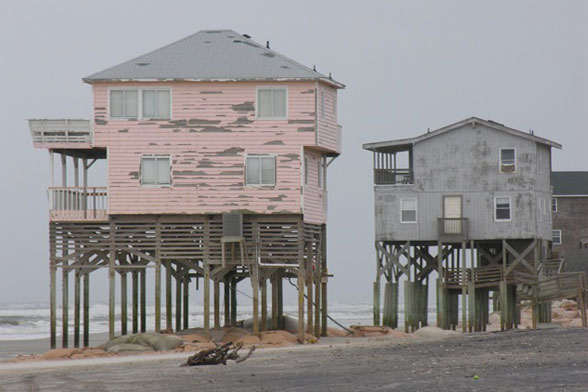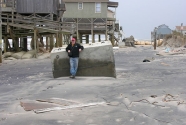
Coastal Erosion, South Nags Head, North Carolina. Photo Gallery Courtesy of: © Orrin H. Pilkey, and Norma Longo, Duke University And Joseph T. Kelly, University of Maine
Editor’s note:The N.C. Coastal Resources Commission at its meeting in Beaufort today will once again consider a coastal planning policy for sea-level rise. The commission’s panel of scientific advisors presented the commission with a draft policy in March 2010. It projected that sea level along the N.C. coast could rise 15 to 55 inches by 2100 because of a warming climate. That forecast and most planning recommendations were removed from a later draft after objections from development interests and some coastal counties. The commission asked the Coastal Hazards Science Panel, its advisors, to respond to the objections. The panel did so recently in an “addendum” to its original report in which the so-called “Science Panel” unanimously reaffirmed its findings. All of the authors, except for Dr. Reide Corbett, are members of the panel.—Coastal Review Online
By Robert S. Young, D. Reide Corbett, David Mallinson,
Charles “Pete” Peterson, Stanley R. Riggs, Antonio B. Rodriguez
We would like to take this opportunity to add our own personal perspective to the just completed “addendum” report authored by the Science Panel. It should come as no surprise that the panel unanimously voted to support the science behind the projections in our first report. The Science Panel is composed of very well qualified scientists and engineers, some of whom have spent their careers examining the nature and impacts of changing sea levels in North Carolina. The state is fortunate to have such expertise available for consultation.
No one wants to think about the potential for a meter of sea level rise, but this projection is clearly the national and international consensus being used for planning the potential impacts of rising sea level over the next century.
Much has been said in the media over the last few months, and we respect the right of all North Carolinians to have their say, and to participate in the discussion. We would like to address a few of what we believe are important misunderstandings or misconceptions:
There is no scientific consensus on global climate change and the expected acceleration of sea level rise: There is, in fact, clear scientific consensus on global climate change amongst scientists. Every major scientific organization in the United States, Europe, and Asia has produced statements supporting the science behind the human contribution to global warming and indicating an expected acceleration in the rate of sea-level rise over the next century.
There are other viewpoints, but they do not represent the vast majority of scientists. We like to think of it this way. If you had a persistent cough, and you went to 100 doctors for a diagnosis and 98 doctors said you had lung cancer, while two doctors said you simply had a throat tickle, we are guessing that you would take the cancer diagnosis seriously. You might even begin to seek treatment. In the case of sea-level rise, 98 of the 100 scientists are telling you that there will be an acceleration in the rate of rise this century. It is up to you to decide what to do about it.
These scientific organizations embrace climate change so that they can continue to get grant money: This assertion is a bit absurd. Organizations like the National Academies, the American Association for the Advancement of Science, the Geological Society of America, the American Geophysical Union and many others have all supported the science behind global change. Yet, a very, very small percentage of their members conduct funded climate change research. Rather, these diverse groups of scientists have examined the evidence and, based on the facts, found it to be convincing enough to produce scientific statements regarding the need for public action and continued research.
If it is true that these policy statements will lead to an increase in the funding for global change research, then all of the other scientists in these organizations have just “shot themselves in the foot.” There is only so much research money to go around. If it is all going to climate change, then the other scientists in these many organizations are likely to have less funding available for their particular research interest.
A far more likely scenario than a conspiracy to get funding is this: The scientists and engineers in these organizations looked at the peer-reviewed literature and concluded that global change is real, and that an expectation for an acceleration in the rate of sea-level rise is reasonable.
Even talking about one meter of sea-level rise will impact insurance rates and harm the coastal economy: We find this hard to believe. First of all, the insurance companies are well aware of the science behind global climate change and the prevailing projections of sea-level rise. They have funded much research into the science, hazards and risks associated with sea-level rise, coastal erosion and storms. Nothing in the Science Panel’s report or the discussion at the Coastal Resources Commission will come as a surprise to the insurance industry.
Second, the real and immediate threat along the N.C. coast remains property damage resulting from storms. Some areas of the United State have experienced multiple storm impacts; yet, their coastal economies continue to thrive. Dauphin Island, Ala., has been nearly wiped off the map several times in the last 30 years. Each time the barrier island was rebuilt, and the economy there chugs along. One might question whether or not this is good policy, but it is hard to imagine that something as abstract as a 100-year projection for rising sea level is going to impact the coastal economy when the very real prospect of storm impacts has not slowed coastal growth.
The scientists and engineers who project a one-meter sea-level rise by 2100 are calling for an abandonment of the coast: This is simply not true. Currently, the rate of sea-level rise does not appear to be accelerating (although scientists do expect that to change in the future). If you are building a single-family home, or a subdivision, you probably don’t need to do anything other than account for storms. In many respects, the best way to prepare for sea-level rise over the next two to three decades is simply to do a better job of preparing for major storm impacts. If you are building a nuclear power plant, an airbase or a major port facility (all of which are expected to last longer than a single-family home), you should take the potential for sea-level rise into consideration.
We may never get to that projected one meter of sea-level rise: We WILL experience a sea-level rise of one meter. We don’t know if it will be 75 years from now or 150 years from now, but we will get there. As we do, the map of Eastern North Carolina will change. It has already changed dramatically from the last 500 years of sea-level rise. The uncertainty in the future rate and acceleration of global sea-level rise is the main reason why the Science Panel suggested updating and reviewing the report’s projections every five years. Regardless, it is perfectly reasonable for local and state planners to begin consideration of how the map may change in order to develop very long-term plans for adjusting. This is done in order to preserve and protect the coastal economy, not to plan its abandonment.
One final note, we all have a stake in the preservation of North Carolina’s coastal resources, North Carolina’s coastal economy and the wise management of both. Discussing the potential for future sea-level rise in a frank, polite and constructive manner is our effort to contribute to that wise management. We hope that it will be received as such.
About The Authors: The Scientists
Dr. Robert S. Young, director, Program for the Study of Developed Shorelines / Western Carolina University; Dr. Reide Corbett, professor and senior scientist, Institute of Coastal Science and Policy, East Carolina University; Dr. David Mallinson, associate professor of geological sciences, East Carolina University; Dr. Charles “Pete” H. Peterson, distinguished professor, Institute of Marine Sciences, University of North Carolina at Chapel Hill; Dr. Stanley R. Riggs, distinguished research professor and distinguished professor of geology, East Carolina University; and Dr. Antonio B. Rodriguez, associate professor, Institute of Marine Sciences, University of North Carolina at Chapel Hill.

“A matter of Time.” Beach Erosion, North Carolina. Photo source: ©© Michael Feagans















